Weekly recap
U.S. stocks climbed higher last week, reaching fresh record highs despite the U.S. government officially entering a shutdown after Democrats and Republicans failed to agree on a funding bill to keep the federal government funded.
The focus was on the ADP payrolls as the highlight of the economic calendar, given that the shutdown meant nonfarm payrolls weren’t released. ADP payrolls came in significantly weaker than expected, falling by 32,000, defying expectations of a rise of 50,000. The data highlighted weaknesses in the US jobs market, cementing expectations that the Federal Reserve will cut rates by 25 basis points at the October meeting, despite the ongoing shutdown.
Fed rate cut expectations helped drive U.S. stocks to fresh record highs. The S&P 500 rose 1% across the week, hitting a peak of 6730. The Nasdaq rallied 1.3% to an ATH. Gold also charged higher, gaining 2.7% last week, marking the seventh straight weekly gain. Meanwhile, the US dollar fell against its major peers by 0.4%.
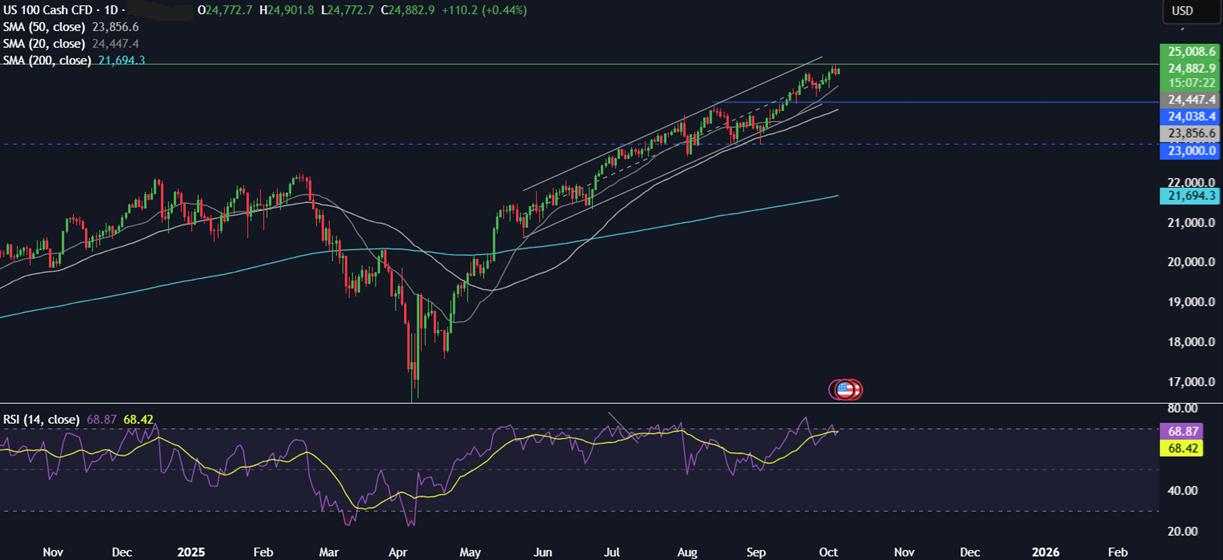
Japanese elections (Saturday)
Japanese stock markets have jumped, while the yen and long-dated government bonds are under pressure, following the surprise victory of pro-stimulus candidate Sanae Takaichi in the nation’s leadership elections held over the weekend. Takaichi is a supporter of easy fiscal and monetary policy; her win has raised concerns over rising bond supplies, while reducing expectations for a BoJ rate hike later this month. Takaichi is expected to become Japan’s first female Prime Minister later this month after winning the Liberal Democrat party leadership contest on Saturday. The USD/JPY has jumped 1.9% higher due to yen weakness.
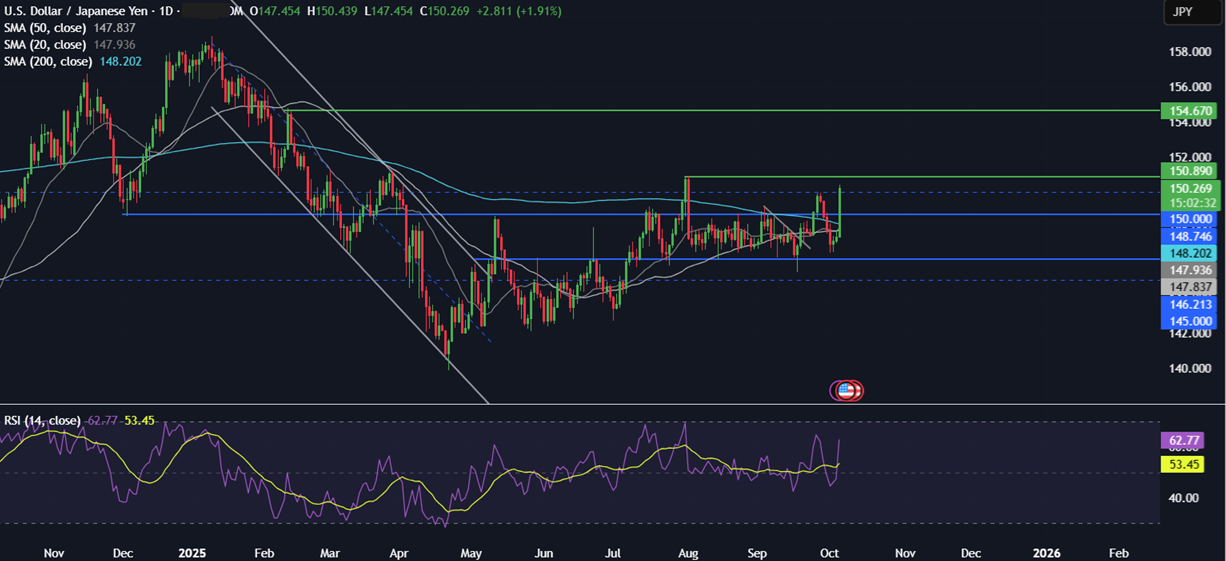
OPEC+ (Sunday)
OPEC+ agreed to raise oil output by 137,000 barrels per day in November. This was significantly less than the rumoured 500k bpd increase that had been expected and which had pulled oil prices 7% lower last week. As a result, oil prices are likely to rebound at the start of the week as the market recovers from the overdone move. Still, gains in oil could be limited given signs of a slowing US economy, which could impact the demand picture.
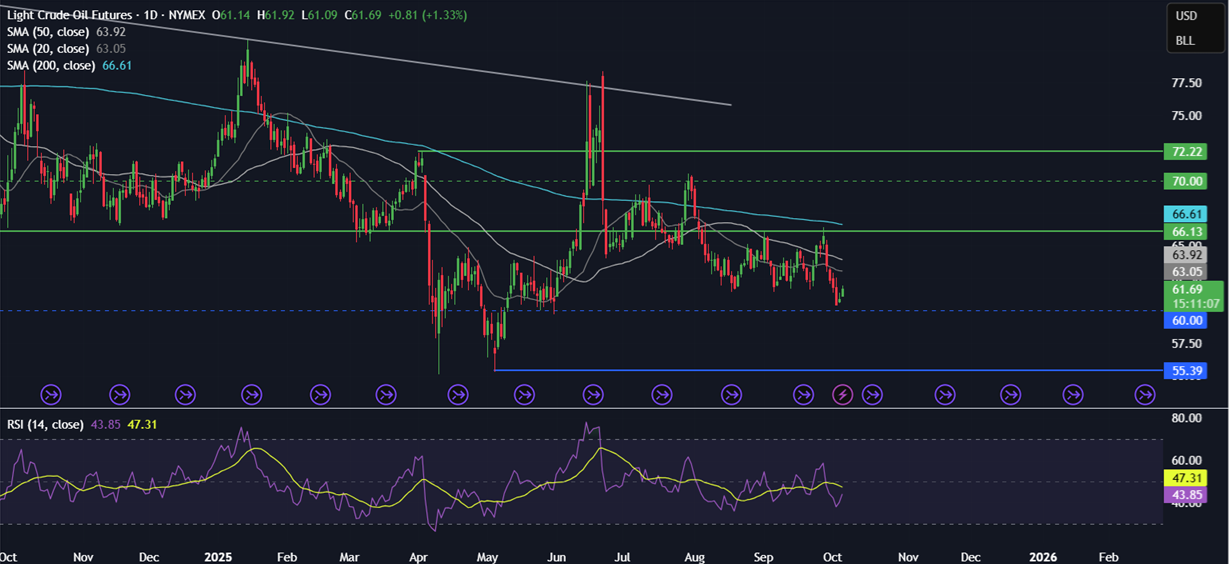
Eurozone retail sales (Monday)
Eurozone retail sales are expected to rise 0.1% MoM in August. Sales slumped 0.5% in July, raising doubts about whether healthy domestic consumption will continue to offset the impact of US tariffs on economic growth. Recent eurozone sentiment data indicate that economic confidence remains stable. Although unemployment did tick up unexpectedly to 6.3% this remains around historic lows. Recent PMI data have also been encouraging, suggesting that the eurozone economy may be on the right path, albeit moving very slowly. The retail sales are unlikely to have a significant impact on the ECB’s policy outlook, given that the central bank is comfortable with current inflation levels. The ECB is not expected to cut interest rates again this year, and there’s only a slight possibility of another interest rate cut before 2026. The ECB minutes will be released on Thursday; however, given that these are a month old, they are considered stale. Watch EUR/USD, which consolidates below 1.1750.
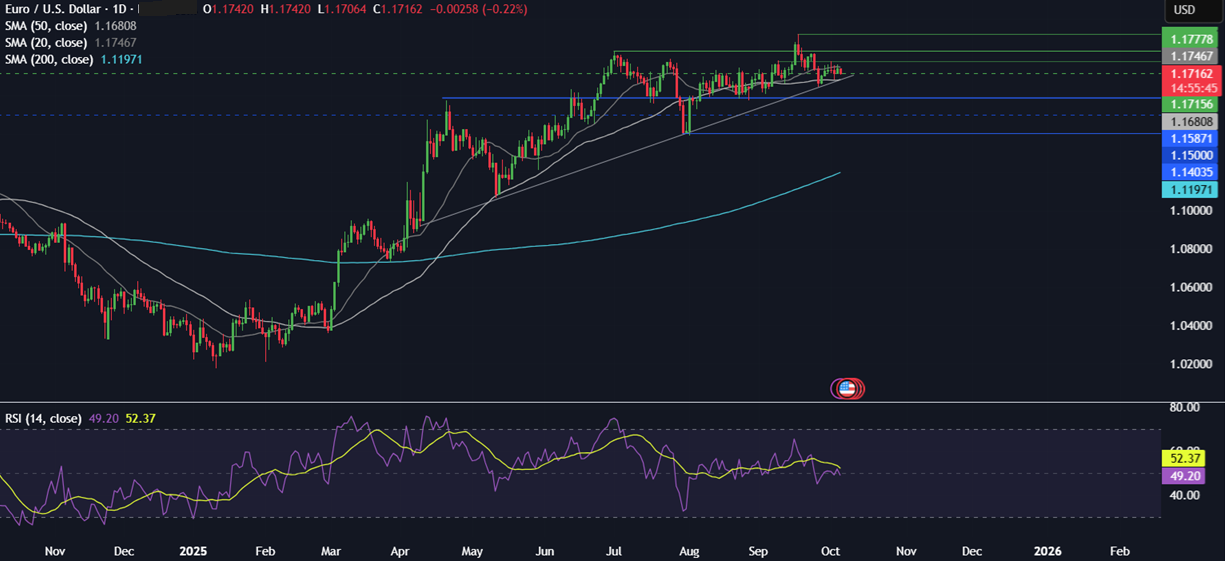
Bank of England governor Andrew Bailey speaks (Monday)
BoE governor Andrew Bailey is due to speak on Monday. His comments will be closely watched, as the UK PMI data this week suggests that momentum and confidence in the UK economy are fading ahead of the November budget. Recent industry data has also indicated that hiring intentions are at their weakest since the pandemic. The outlook appears to be deteriorating, and concerns are rising that the Chancellor will hike taxes again, which could further slow growth. Meanwhile, inflation remains sticky. The BoE cut rates in August to 4% and is not expected to cut rates again this year. A dovish-sounding Bailey could pull GBP/USD lower.
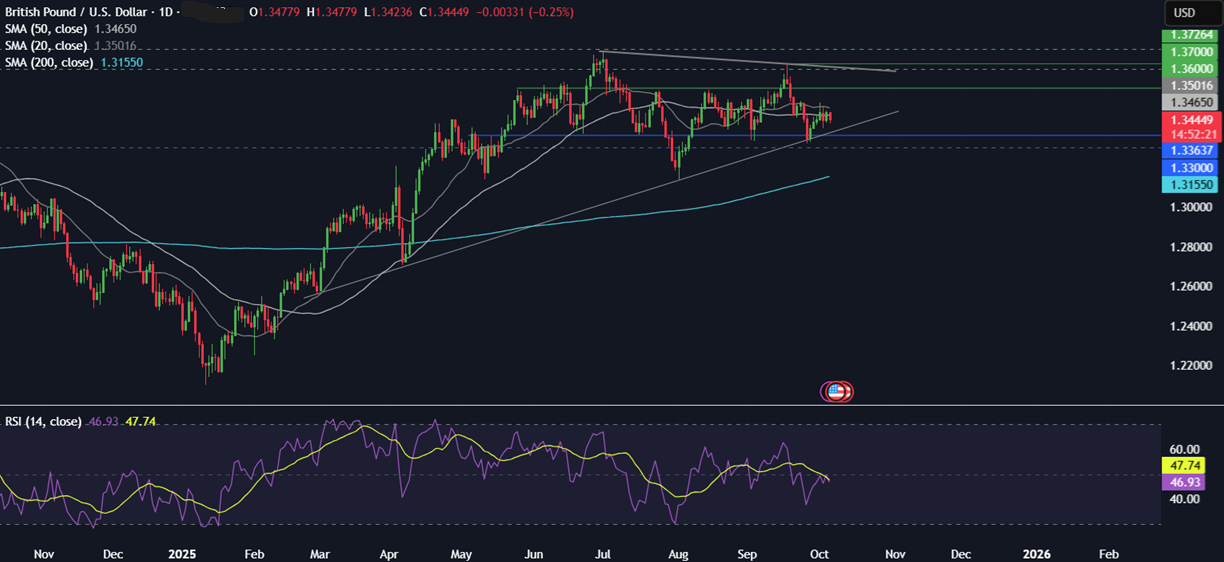
RBNZ rate decision (Wednesday)
The RBNZ is expected to cut interest rates, but the size of the reduction remains unclear. The majority (55%) expect a 25-basis-point reduction, taking the OCR to 2.75% from 3%. However, the market is pricing in a 45% probability that the RBNZ could cut rates by a larger 25 basis points to 2.5%. The central bank resumed rate cuts in August, after pausing in July, to support the stalling economy as US tariffs and stagnant housing market dampened confidence. Q2 GDP was significantly weaker than the RBNZ expected at -0.9% QoQ. A 25 bps cut leaves the RBNZ the option to cut again in November. A dovish-sounding RBNZ could pull the NZD/USD pair lower.
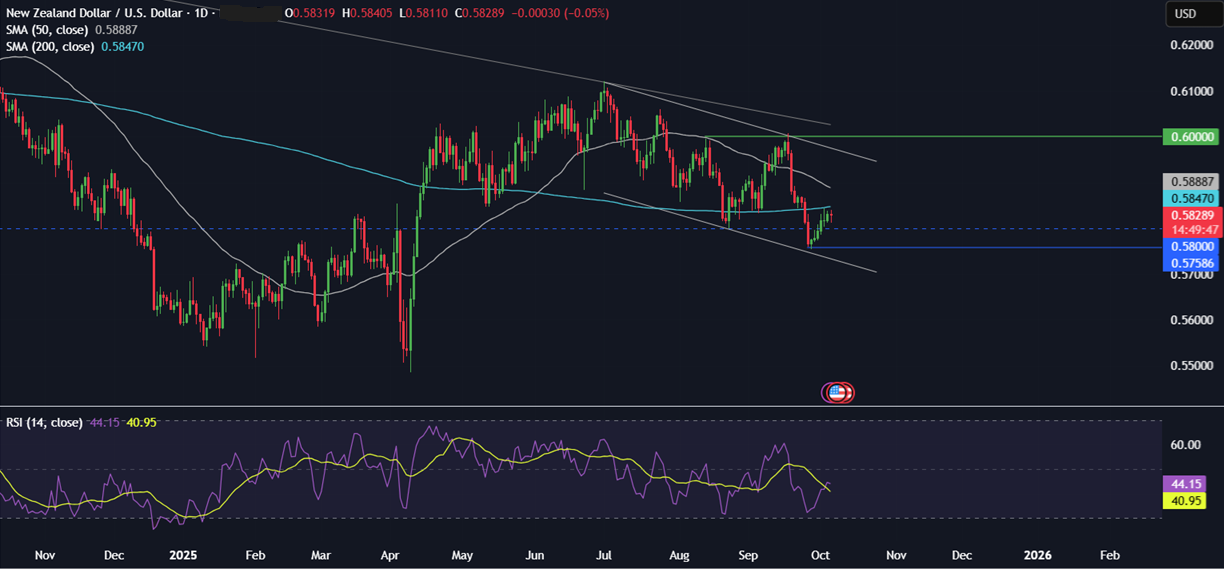
FOMC minutes & Powell speech (Wednesday, Thursday)
Given the ongoing U.S. government shutdown, U.S. economic data will be in short supply; however, attention will be focused on the minutes of the September Fed meeting and on a plethora of Fed speakers, including Fed Chair Powell.
The minutes pertain to the September meeting, where the Fed cut rates for the first time this year by 25 basis points, although divisions existed within the board. Whilst Bowman and Waller pushed for a rate cut in July, they backed the consensus reduction of 25 basis points in September; meanwhile, Stephen Miran, Trump’s new appointee, voted for a 50-basis-point reduction. The updated projections showed that 9 of 19 policymakers see two additional cuts this year.
Recent commentary from Fed speakers suggests that not all members are convinced that inflation has been tamed, although there are growing concerns over the health of the US labor market. The markets will be watching to see whether the Fed minutes add anything to the discussion surrounding the timing of the next Fed rate cut, as the market price currently indicates a 97% probability of a 25-basis-point reduction in October, compared to an 80% chance of a further reduction in December. Dovish-sounding minutes or comments from Powell could further boost the gold price, which is currently trading at a record high.
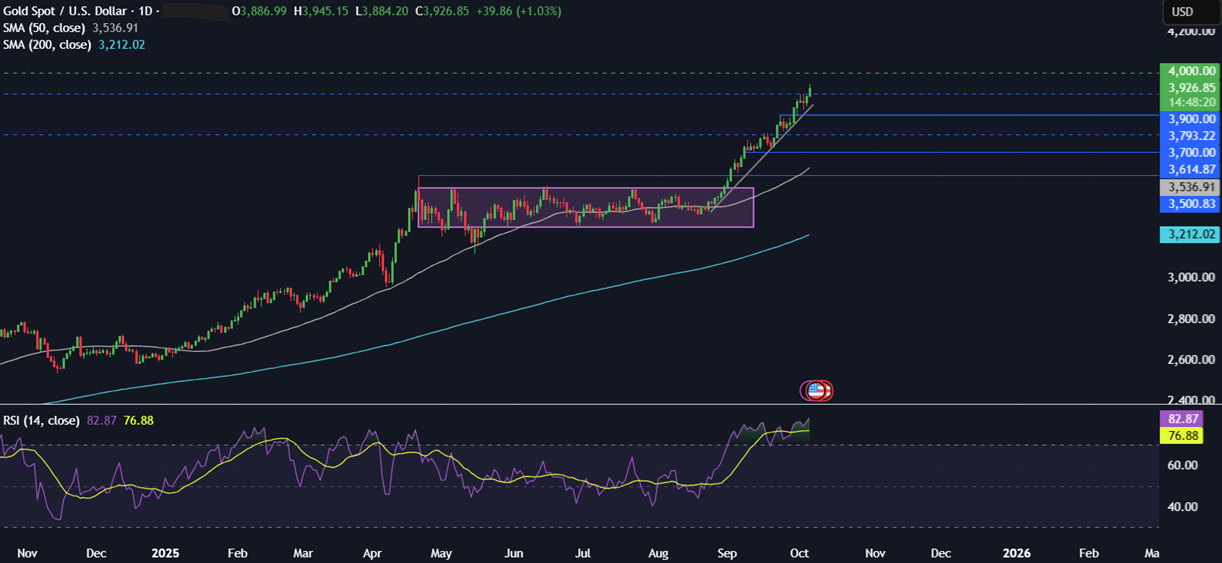
Canadian unemployment (Friday)
Figures surrounding the Canadian jobs market will be in focus to see whether the recent slowdown in the labour market continues. Unemployment rose to 7.1% in August, a 9-year high, excluding the pandemic, as concerns about tariffs dampened business confidence. Owing to the deterioration of the labour market and with inflation remaining within target, the Bank of Canada reduced its rates by 25 basis points, as expected. BoC Governor Macklem noted that a softer labour market has diminished upward pressure on inflation, as well as the removal of most retaliatory tariffs from Canada. The central bank also removed guidance saying it will proceed carefully. Another weak jobs report could boost expectations of an October Bank of Canada cut, with the market pricing in a 60% probability of a rate cut this month. Weak jobs data could lift USD/CAD higher.
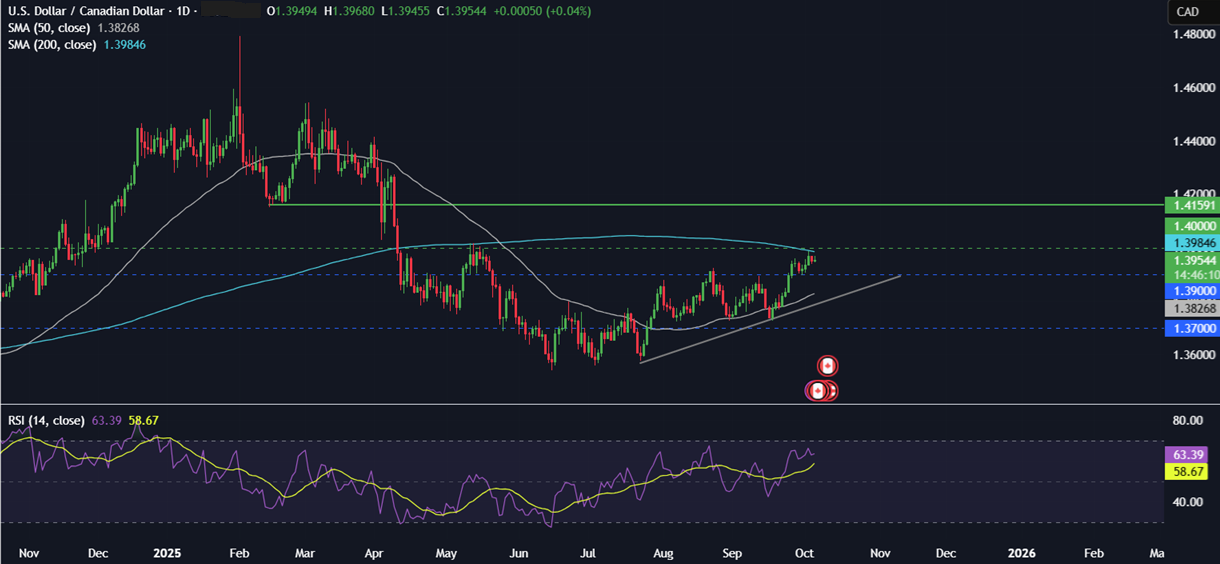
Trading involves risk.
The content provided here is for informational purposes only. It is not intended as personal investment advice and does not constitute a solicitation or invitation to engage in any financial transactions, investments, or related activities. Past performance is not a reliable indicator of future results.
The financial products offered by the Company are complex and come with a high risk of losing money rapidly due to leverage. These products may not be suitable for all investors. Before engaging, you should consider whether you understand how these leveraged products work and whether you can afford the high risk of losing your money.
The Company does not accept clients from the Restricted Jurisdictions as indicated in our website/ T&C. Some services or products may not be available in your jurisdiction.
The applicable legal entity and its respective products and services depend on the client’s country of residence and the entity with which the client has established a contractual relationship during registration.




